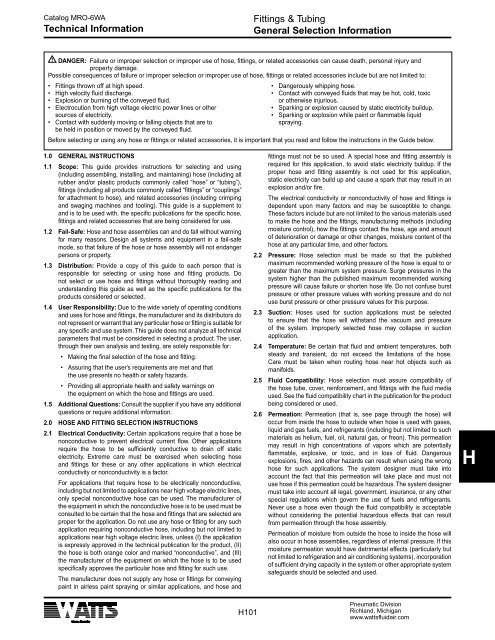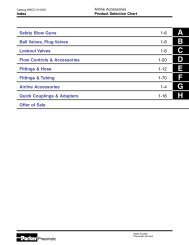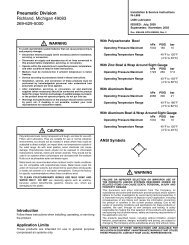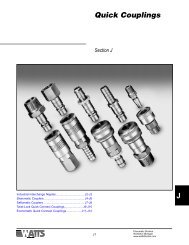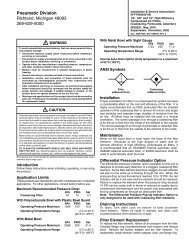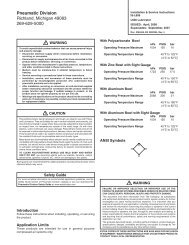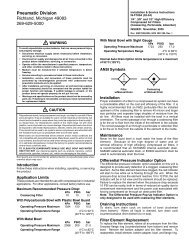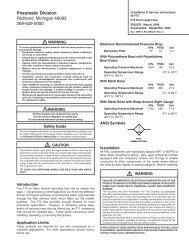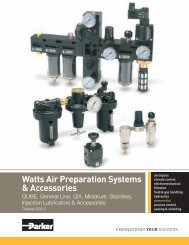Specification - Watts Fluid Air
Specification - Watts Fluid Air
Specification - Watts Fluid Air
Create successful ePaper yourself
Turn your PDF publications into a flip-book with our unique Google optimized e-Paper software.
Catalog MRO-6WATechnical InformationFittings & TubingGeneral Selection Information! DANGER: Failure or improper selection or improper use of hose, fittings, or related accessories can cause death, personal injury andproperty damage.Possible consequences of failure or improper selection or improper use of hose, fittings or related accessories include but are not limited to:• Fittings thrown off at high speed.• Dangerously whipping hose.• High velocity fluid discharge.• Contact with conveyed fluids that may be hot, cold, toxic• Explosion or burning of the conveyed fluid.or otherwise injurious.• Electrocution from high voltage electric power lines or other• Sparking or explosion caused by static electricity buildup.sources of electricity.• Sparking or explosion while paint or flammable liquid• Contact with suddenly moving or falling objects that are tospraying.be held in position or moved by the conveyed fluid.Before selecting or using any hose or fittings or related accessories, it is important that you read and follow the instructions in the Guide below.1.0 GENERAL INSTRUCTIONS1.1 Scope: This guide provides instructions for selecting and using(including assembling, installing, and maintaining) hose (including allrubber and/or plastic products commonly called “hose” or “tubing”),fittings (including all products commonly called “fittings” or “couplings”for attachment to hose), and related accessories (including crimpingand swaging machines and tooling). This guide is a supplement toand is to be used with, the specific publications for the specific hose,fittings and related accessories that are being considered for use.1.2 Fail‐Safe: Hose and hose assemblies can and do fall without warningfor many reasons. Design all systems and equipment in a fail‐safemode, so that failure of the hose or hose assembly will not endangerpersons or property.1.3 Distribution: Provide a copy of this guide to each person that isresponsible for selecting or using hose and fitting products. Donot select or use hose and fittings without thoroughly reading andunderstanding this guide as well as the specific publications for theproducts considered or selected.1.4 User Responsibility: Due to the wide variety of operating conditionsand uses for hose and fittings, the manufacturer and its distributors donot represent or warrant that any particular hose or fitting is suitable forany specific and use system. This guide does not analyze all technicalparameters that must be considered in selecting a product. The user,through their own analysis and testing, are solely responsible for:• Making the final selection of the hose and fitting.• Assuring that the user’s requirements are met and thatthe use presents no health or safety hazards.• Providing all appropriate health and safety warnings onthe equipment on which the hose and fittings are used.1.5 Additional Questions: Consult the supplier if you have any additionalquestions or require additional information.2.0 HOSE AND FITTING SELECTION INSTRUCTIONS2.1 Electrical Conductivity: Certain applications require that a hose benonconductive to prevent electrical current flow. Other applicationsrequire the hose to be sufficiently conductive to drain off staticelectricity. Extreme care must be exercised when selecting hoseand fittings for these or any other applications in which electricalconductivity or nonconductivity is a factor.For applications that require hose to be electrically nonconductive,including but not limited to applications near high voltage electric lines,only special nonconductive hose can be used. The manufacturer ofthe equipment in which the nonconductive hose is to be used must beconsulted to be certain that the hose and fittings that are selected areproper for the application. Do not use any hose or fitting for any suchapplication requiring nonconductive hose, including but not limited toapplications near high voltage electric lines, unless (I) the applicationis expressly approved in the technical publication for the product, (II)the hose is both orange color and marked “nonconductive”, and (III)the manufacturer of the equipment on which the hose is to be usedspecifically approves the particular hose and fitting for such use.The manufacturer does not supply any hose or fittings for conveyingpaint in airless paint spraying or similar applications, and hose andfittings must not be so used. A special hose and fitting assembly isrequired for this application, to avoid static electricity buildup. If theproper hose and fitting assembly is not used for this application,static electricity can build up and cause a spark that may result in anexplosion and/or fire.The electrical conductivity or nonconductivity of hose and fittings isdependent upon many factors and may be susceptible to change.These factors include but are not limited to the various materials usedto make the hose and the fittings, manufacturing methods (includingmoisture control), how the fittings contact the hose, age and amountof deterioration or damage or other changes, moisture content of thehose at any particular time, and other factors.2.2 Pressure: Hose selection must be made so that the publishedmaximum recommended working pressure of the hose is equal to orgreater than the maximum system pressure. Surge pressures in thesystem higher than the published maximum recommended workingpressure will cause failure or shorten hose life. Do not confuse burstpressure or other pressure values with working pressure and do notuse burst pressure or other pressure values for this purpose.2.3 Suction: Hoses used for suction applications must be selectedto ensure that the hose will withstand the vacuum and pressureof the system. Improperly selected hose may collapse in suctionapplication.2.4 Temperature: Be certain that fluid and ambient temperatures, bothsteady and transient, do not exceed the limitations of the hose.Care must be taken when routing hose near hot objects such asmanifolds.2.5 <strong>Fluid</strong> Compatibility: Hose selection must assure compatibility ofthe hose tube, cover, reinforcement, and fittings with the fluid mediaused. See the fluid compatibility chart in the publication for the productbeing considered or used.2.6 Permeation: Permeation (that is, see page through the hose) willoccur from inside the hose to outside when hose is used with gases,liquid and gas fuels, and refrigerants (including but not limited to suchmaterials as helium, fuel, oil, natural gas, or freon). This permeationmay result in high concentrations of vapors which are potentiallyflammable, explosive, or toxic, and in loss of fluid. Dangerousexplosions, fires, and other hazards can result when using the wronghose for such applications. The system designer must take intoaccount the fact that this permeation will take place and must notuse hose if this permeation could be hazardous. The system designermust take into account all legal, government, insurance, or any otherspecial regulations which govern the use of fuels and refrigerants.Never use a hose even though the fluid compatibility is acceptablewithout considering the potential hazardous effects that can resultfrom permeation through the hose assembly.Permeation of moisture from outside the hose to inside the hose willalso occur in hose assemblies, regardless of internal pressure. If thismoisture permeation would have detrimental effects (particularly butnot limited to refrigeration and air conditioning systems), incorporationof sufficient drying capacity in the system or other appropriate systemsafeguards should be selected and used.HH101Pneumatic DivisionRichland, Michiganwww.wattsfluidair.com


